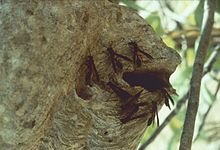| Polybia sericea | |
|---|---|

| |
| Scientific classification | |
| Domain: | Eukaryota |
| Kingdom: | Animalia |
| Phylum: | Arthropoda |
| Class: | Insecta |
| Order: | Hymenoptera |
| Family: | Vespidae |
| Subfamily: | Polistinae |
| Genus: | Polybia |
| Species: | P. sericea
|
| Binomial name | |
| Polybia sericea (Olivier, 1792)
| |
Polybia sericea is a social, tropical wasp[1] of the family Vespidae that can be found in South America.[2] It founds its colonies by swarming migrations, and feeds on nectar[3] and arthropods.[1]
P. sericea is medium in size, and has a dark-colored body.[4] The wasps build multitiered nests, and colony size can vary greatly between a few to a few thousand workers.[2] Queens can be distinguished from workers by their greater body size and smaller head size.[2] They tend to be polygynous, meaning that several egg-laying queens are within a nest, with the result that workers are generally less related to each other than in other eusocial species.[5] Workers are responsible for hunting and foraging, while queens are responsible for laying eggs, and have the most developed ovaries. When hunting for prey, workers rely heavily on visual and olfactory cues.[1] Prey include arthropods such as green and brown caterpillars.
- ^ a b c Richter, M.A. Raveret; R.L. Jeanne (1985). "Predatory Behavior of Polybia sericea (Olivier), a tropical wasp (Hymenoptera: Vespidae)". Behavioral Ecology and Sociobiology. 16 (2): 165–170. doi:10.1007/BF00295151.
Olfactory cues were more likely to elicit landing than were visual cues.
- ^ a b c Desuó, IC; CB Souza-Galheico (2011). "An Adaptive View of Caste Differentiation in the Neotropical Wasp Polybia (Trichothorax) sericea Olivier (Hymenoptera: Vespidae)". Neotropical Entomology. 40 (6): 653–660. doi:10.1590/S1519-566X2011000600004. hdl:11449/26723. PMID 23939271.
- ^ Bichara Filho, Carlos C.; Gilberto M. de M. Santos (2010). "Foraging Behavior of the Swarm Founding Wasp Polybia (Trichothorax) sericea (Hymenoptera: Vespidae): Daily Resource Collection Activity and Flight Capacity" (PDF). Sociobiology. Retrieved 2014-10-03.
- ^ Jeanne, Robert L. (1981). "Chemical Communication During Swarm Emigration in the Social Wasp Polybia sericea (Olivier)". Animal Behaviour. 29: 102–113. doi:10.1016/S0003-3472(81)80157-1.
- ^ Queller, David C.; Joan E. Strassman (1988). "Genetic Relatedness in Colonies of Tropical Wasps with Multiple Queens". Science. 242 (4882): 1155–1157. Bibcode:1988Sci...242.1155Q. doi:10.1126/science.242.4882.1155. PMID 17799732.
